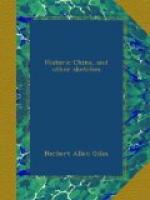It is well known that all old and even middle-aged people in China like to have their coffins prepared ready for use. A dutiful son will see that his parents are thus provided, sometimes many years before their death, and the old people will invite relatives or friends to examine and admire both the materials and workmanship, as if it were some beautiful picture or statue of which they had just cause to be proud. Upon the coffin is carved an inscription with the name and titles of its occupant; if a woman, the name of her husband. At the foot of the coffin are buried two stone tablets face to face; one bears the name and title of the deceased, and the other a short account of his life, what year he was born in, what were his achievements as a scholar, and how many children were born to him. Periods of mourning are regulated by the degrees of relationship to the dead. A son wears his white clothes for three years—actually for twenty-eight months; and a wife mourns her husband for the same period. The death of a wife, however, calls for only a single year of grief; for, as the Sacred Edict points out, if your wife dies you can marry another. The same suffices for brother, sister, or child. Marriages contracted during these days of mourning are not only invalid, but the offending parties are punished with a greater or lesser number of blows according to the gravity of the offence. Innumerable other petty restrictions are imposed by national or local custom, which are observed with a certain amount of fidelity, though instances are not wanting where the whole thing is shirked as inconvenient and a bore.
Cremation, once the prevailing fashion in China, is now reserved for the priest of Buddha alone,—that self-made outcast from society, whose parting soul relies on no fond breast, who has no kith or kin to shed “those pious drops the closing eye requires;” but who, seated in an iron chair beneath the miniature pagoda erected in most large temples for that purpose, passes away in fire and smoke from this vale of tears and sin to be absorbed in the blissful nothingness of an eternal Nirvana.
INQUESTS
Inquests in China serve, unfortunately, but to illustrate one more phase of the folly and ignorance which hopelessly overshadow the vast area of its Empire. For although the Chinese justly regard such investigations as matters of paramount importance, and the office of coroner devolves upon a high functionary—the district magistrate—yet the backward state of science on the one hand, and the necessity the ruling classes have been under of supplying this deficiency on the other, have combined to produce at once the most deplorable and the most laughable results. Two good-sized volumes of “Instructions to Coroners,” beautifully printed on white paper and altogether handsomely got up, are published under the authority of the Government, and copies of this book are to




